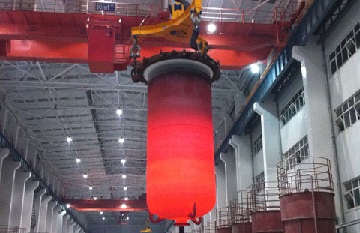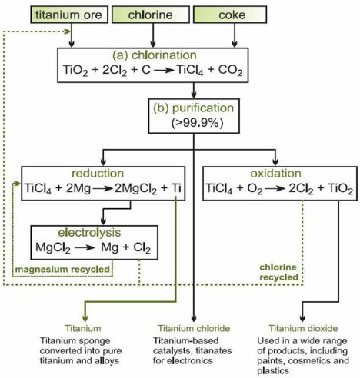Introduction to Titanium and Titanium Alloy
1. The History and Development of Titanium Industry

A distillation vessel for a chemical plant in US, made of titanium Gr.2.
Titanium was firstly discovered by an British mineralogist Mr. Gregor 220 years ago. However, modern titanium industry was not established until 1948 when the famous Kroll Process was introduced by an US company. China’s titanium industry started in 1950’s. We had established an integrated industrial system during the 1960’s and 1970’s. Several titanium production centers were established including Shanxi and Hebei. Nowadays, the annual yield of titanium is over 125,000 metric tons. Hebei Metals Industrial Limited is an eminent supplier of various titanium piping materials. Our product range covers bar, wire, strip, sheet, plate, pipe & tube, fitting, forging, casting, bolt, nut, screw, heat exchanger, reactor and other pressure vessels.
2. The Production of Titanium: Kroll Process
Economically, titanium shall be produced by Kroll process. It involves reduction of titanium tetrachloride(TiCl4, also know as “tickle”), first with sodium(Na) and Calcium(Ca), and later with magnesium(Mg), under inert gas atmosphere. The resultant titanium sponge is then further processed(consolidated, alloyed, or remelted). Generally, TiCl4, which shall be subsequently purified by distillation, is attained by the chlorination process involving titanium dioxide(TiO2). The two basic reactions are shown below:
- TiO2(s) + 2Cl2(g) + C(s) → TiCl4(g) + CO2(g)
- TiCl4(g) + 2Mg(l) → 2MgCl2(s)+ Ti(s)

The Kroll process flow chart for the production of titanium sponge.
3. Microstructure of Titanium and Titanium Alloys
The unalloyed titanium, also known as pure titanium, exists in two allotropic crystallographic forms: alpha(α) phase and beta(β) phase. At room temperature, it has a hexagonal close-packaged(hcp) crystal structure which is referred to as α phase. At 883°C(1621°F), it transforms to body-centered cubic(bcc) structure known as β phase. Similarly, titanium alloys can be classified as either α alloys, β alloys, or α+β alloys. A wide range of titanium alloys can be developed by manipulating these crystallographic forms through alloying additions and thermo-mechanical processing.
4. Applications of Titanium and Titanium Alloys
Titanium and titanium alloys are featured for its outstanding corrosion resistance and specific high strength at low or high temperatures and pressures. They can be widely used for various services including: aerospace components, jet engines, chemical processing, pulp and paper industry, marine project, and power plant heat exchangers, surgical implants, prosthetic devices, superconductivity, shape-memory effect, automotive industry, as well as jewelry, and golf club head, etc.
